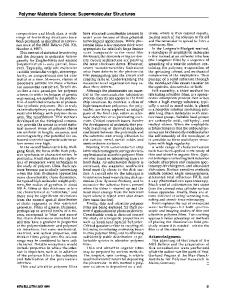Characterization of polymer materials using magnetic levitation
- PDF / 561,614 Bytes
- 8 Pages / 584.957 x 782.986 pts Page_size
- 7 Downloads / 300 Views
Characterization of polymer materials using magnetic levitation Jun Xie1, Peng Zhao1,a)
, Jianfeng Zhang1, Hongwei Zhou2, Jianzhong Fu1, Lih-Sheng Turng3
1
The State Key Laboratory of Fluid Power and Mechatronic Systems, Key Lab of 3D Printing Process and Equipment of Zhejiang Province, Zhejiang University, Hangzhou 310027, China 2 Research and Development Department, Tederic Machinery Co., Ltd, Hangzhou, 311124, China 3 Wisconsin Institute for Discovery, Department of Mechanical Engineering, University of Wisconsin–Madison, Madison, Wisconsin 53706, USA a) Address all correspondence to this author. e-mail: [email protected] Received: 14 December 2019; accepted: 26 February 2020
The quality of the polymer raw material used in plastic processing methods is an important characteristic because it is one of the main factors in producing quality products. Therefore, the characterization of polymeric pellets in the polymer processing industry is very important to avoid using inferior materials. In general, differences in the interiors of polymeric pellets reflect differences in their densities. In this study, a highsensitivity magnetic levitation method was used to characterize the polymeric pellets in four different occasions. The device used has a high sensitivity that can distinguish minute differences as small as of 0.0041 g/ cm3 in density between different samples. In addition, the method can obtain a sample’s density without knowing the weight and volume of the sample. This method can be used to characterize materials by testing only a single pellet, which is very useful for polymeric pellet characterization.
Introduction Polymers represent a large class of processing materials that have been widely used in industrial sectors such as aerospace and automotive, petroleum and natural gas, nuclear and electric power plants, and biological and medical applications [1]. This is because polymers include a wide variety of different grades and types of materials that are applicable for many different applications. It is important to distinguish each individual material from the larger group because little differences between materials can significantly affect final part quality. For instance, the same material with different drying conditions will have different characteristics, which could lead to defects such as interior voids or silver streaks [2]. Different types of thermoplastic polyurethane (TPU) have different components and different mechanical properties [3, 4]. As reported in the literature, Desmopan DP 9370AU (TPU) has a shore hardness of 70A [3], while Estane 58315 (TPU) has a shore hardness of 85A [4]. In addition, adding different percentages of glass fibers to reinforce polymers yields different mechanical and processing properties [5]. This difference varied from 43 to 77 MPa as the amount of added E-glass fiber increased from 15 to 30 wt% in polyester resin [6].
ª Materials Research Society 2020
Therefore, the characterization of materials is an important step in the quality control of a product. There
Data Loading...











